Now You're Cookin'! Tasty, Healthful Meals on a Budget Week 5:Time-saving Tips, Menus and Recipes (FN1387, Reviewed August 2021)
Availability: Web only
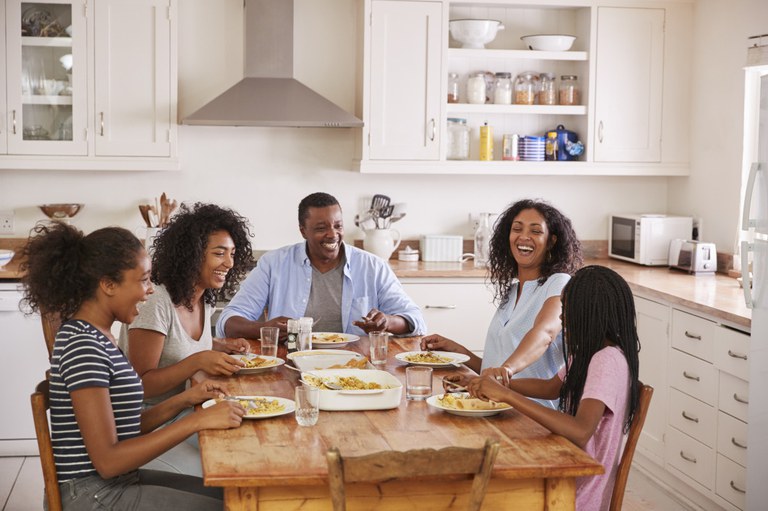
iStock
Time vs. Money
Which statement is true of you? Mark with an “X.”
- I plan menus and write grocery lists, so I have meal ideas and the food I need.
- I sometimes prepare portions of a meal in advance.
- I sometimes use leftovers as the basis for another meal.
- Other people in my household help with meal preparation and cleanup.
- I focus preparation efforts on one portion of the meal. For example, if the main course is time-consuming, I fix a simple vegetable or salad.
- I assemble equipment, cooking utensils and ingredients before I begin meal preparation.
- I use time-saving equipment, such as slow cookers and microwave ovens.
- I use the one-pot method. For example, I add vegetables to pasta that is cooking.
Think about the items you marked and the ones you did not mark. These are time-saving strategies, and some may work for you.
This is the fifth in a series of publications to help you eat well but spend less at the grocery store. It includes time/money-saving tips and sample menus with recipes that you can adapt to meet your family’s tastes.
Plan for Busy Times
Meal planning and advance food preparation can save you time and money. Find a block of time when you can make a few recipes at once and then freeze them for a later date. Invite your family to help. When you’re in a time crunch, allow the dish to thaw in the refrigerator for the day. Reheat in a microwave, add a side salad and dinner is ready.
Example 1: Make extra chili on Monday for “planned-overs” on Wednesday. Use the rest of the chili to:
• Top baked potatoes
• Make an easy casserole by combining cooked pasta shells with planned-over chili
• Make a quick and easy taco salad by topping lettuce with planned-over chili, diced tomatoes and shredded cheese
Example 2: Use a slow cooker to simmer your evening meal to perfection while you are at work or busy doing other things. Mix planned-over beef or chicken, vegetables and broth in your slow cooker before you leave in morning; set on low. Serve with bread, crackers and fruit for a hearty evening meal.
Save Money When Eating Out
With busy lifestyles, sometimes grabbing a meal on the go is unavoidable. Eating out can be an occasional treat that does not have to break your budget. Consider these tips:
• When eating out, take advantage of “two for one” deals, coupons or “kids eat free” specials.
• Drink water instead of ordering soda pop.
• Share a meal, or have an appetizer as your main course.
• Order a kid’s combo when possible. Often the “kid-sized meal” has the accurate portion size for adults.
• If the portions are large, ask for a “to go” box early. Put half of your meal in the box and enjoy the rest for lunch the next day. This practice cuts calories, and it provides a second meal for you.
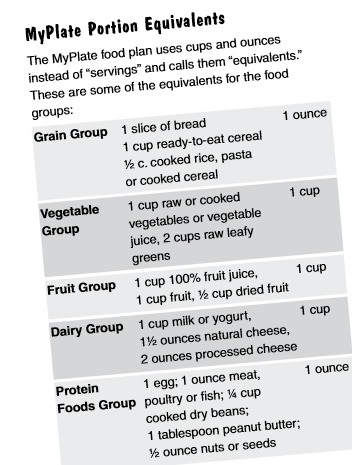
What’s Your MyPlate Plan?
You can find the latest nutrition recommendations .
Each person has different needs based on gender, age and level of physical activity. Learn what each of your family members needs at his or her particular calorie levels by visiting the website or contacting your local Extension agent for “MyPlate Plans” handouts for different age groups.
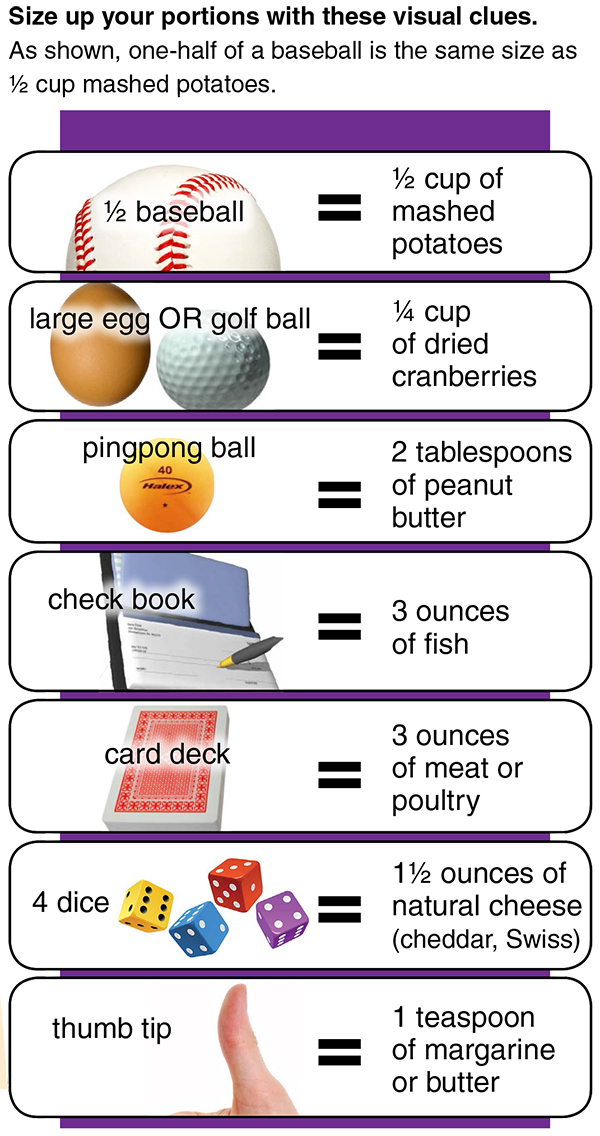
Example: MyPlate Plan and three-day menu plan for a 14-year-old female who gets less than 30 minutes of physical activity per day*
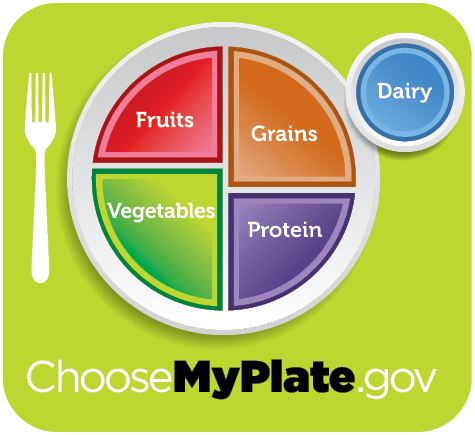
MyPlate Plan*
Grains 6 ounces
Vegetables 2.5 cups
Fruit 1.5 cups
Dairy 3 cups
Protein Foods 5 ounces
Three-day Menu Plan for a 14-year-old Female*
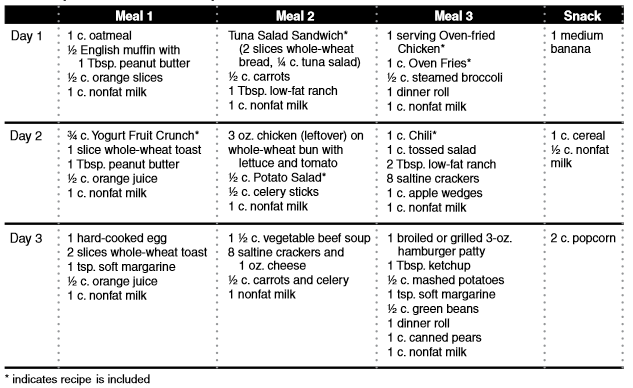
Look for Key Words on the Menu When Eating Out
Some foods prepared with less fat are considered a healthier option when eating out. Try to choose items that are baked, broiled, grilled, roasted, poached, steamed or blackened. Limit fried, braised, basted, creamed, scalloped, au-gratin, sautéed or stuffed and any foods marinated in oil.
For a healthful twist on restaurant-style foods, try the recipes for “Oven Fries” and “Crispy Baked Chicken” included in this publication.
Remember Food Safety on the Run
If you bring food along, be sure to keep perishable foods, such as meat sandwiches, milk and cut-up fruit, cold. Use insulated lunch boxes and bags with frozen gel packs or frozen juice boxes.
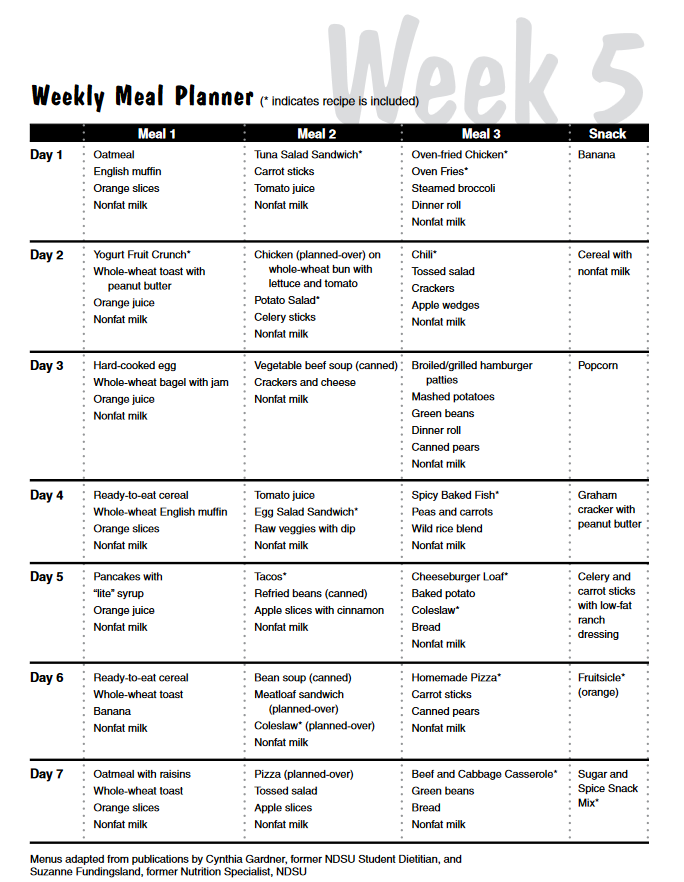
Week 5 Recipes
Key to Abbreviations
tsp. = teaspoon
Tbsp. = tablespoon
c. = cup
oz. = ounce
pkg. = package
g = grams
mg = milligrams
lb. = pound
Oven-fried Chicken
Equipment you will need
• cutting board
• measuring cup
• sharp knife
• measuring spoons
• baking dish
• tongs or fork
• plastic bag
2 tsp. margarine or butter
2/3 c. Master Mix**
½ tsp. paprika, if desired
½ tsp. salt
¼ tsp. pepper
3 lb. chicken
Cut the chicken into serving-sized pieces and take off the skin. Heat the oven to 425 degrees. Melt the margarine in the baking dish in the oven. Mix the Master Mix, paprika, salt and pepper in the plastic bag. Add the chicken pieces and shake. Put the chicken in the baking dish. Bake for 35 minutes, then turn the chicken over and bake 15 minutes more (50 minutes total).
Serves six. Per serving: 340 calories, 9 g fat, 52 g protein, 9 g carbohydrate, 0 g fiber and 480 mg sodium.
Spicy Baked Fish
Equipment you will need
• cutting board
• small sharp knife
• baking dish
• small pan
• mixing spoon
• cheese grater
1 lb. frozen cod fillets, without skin
vegetable oil
¼ c. chopped onion
¼ c. chopped green pepper
1 c. (8-oz. can) chopped tomatoes
1/8 tsp. pepper
½ tsp. oregano
1 c. grated cheese, if you like
Thaw frozen fish in the refrigerator. Cut fish into six servings. Oil baking dish and spread fish in dish. Bake fish in 350-degree oven for 20 minutes. While fish is baking, chop the onion and green pepper. Cook the onion and green pepper in a small pan in a little water for three minutes. Add tomatoes and spices. Cook on stovetop for 10 minutes to blend flavors. When fish is done, pour liquid off. Pour vegetable sauce over fish. Bake 10 minutes. Grate cheese and put over fish. Bake two or three minutes to melt cheese.
Serves six. Per serving: 150 calories, 7 g fat, 18 g protein, 3 g carbohydrate, 1 g fiber and 250 mg sodium.
Yogurt Fruit Crunch
Equipment you will need
• small mixing bowl
• mixing or serving spoon
• 4 small serving dishes
• measuring cup
2 c. low-fat yogurt (plain or vanilla)
1 c. fruit, fresh (1 banana) or canned in light syrup (drained)
1 c. dry cereal, crunchy
Drain fruit if using canned fruit or cut up the fresh fruit. Mix the yogurt and fruit together in a mixing bowl. Spoon the mixture into small serving dishes. Sprinkle ¼ cup cereal on top of each serving.
Serves four. Per serving: 170 calories, 1.5 g fat, 7 g protein, 33 g carbohydrate, 1 g fiber and 135 mg sodium.
Quick Skillet Hot Dish
Equipment you will need
• frying pan
• measuring cup
• can opener
• cooking spoon
1 lb. ground turkey or beef
1 (5 oz.) package macaroni
1 (1 oz.) package dried onion soup mix
1 (15 oz.) can kidney beans
1 (15 oz.) can corn
1 (10½ oz.) can tomato soup or 1 (8 oz.) can tomato sauce plus 1 can water
2 c. water
Brown ground turkey or beef in a frying pan. Drain fat. Add the other ingredients, plus 2 cups water. Cook at a low heat for 10 minutes or until the macaroni is cooked and all the liquid is gone.
Serves six. Per serving: 360 calories, 7 g fat, 26 g protein, 4 g carbohydrate, 6 g fiber and 790 mg sodium.
Developed by the dietetic students at the College of St. Benedict and St. John’s University, Minnesota.
**Master Mix
Equipment you will need
• measuring cups
• measuring spoons
• large mixing bowl
• pastry blender or fork or 2 knives
• mixing spoon
• storage containers
9 c. flour
1/3 c. baking powder
1 Tbsp. salt
2 tsp. cream of tartar
4 Tbsp. sugar
1 c. nonfat dry milk powder
1 c. vegetable oil
Measure flour, baking powder, salt, cream of tartar, sugar and dry milk into mixing bowl. Stir with a spoon to mix well. Measure and add oil. Blend the oil into the dry mix using the pastry blender, the fork or the knives. The mix should look like coarse cornmeal. Store the mix in covered plastic or glass storage containers in the refrigerator.
To use the Master Mix in a recipe, stir the mix in the container, then spoon it carefully into a cup and level it off with a knife.
Makes 11 cups. Use in recipes similar to commercial baking mix.
Ask your local Extension Service office for more recipes featuring “Master Mix.”
Homemade Pizza
Equipment you will need
• cookie sheet or pizza pan
• frying pan
• measuring spoons
• measuring cup
• mixing bowl
• mixing spoon
• can opener
• cheese grater
• cooking spoon
Nonstick cooking spray or vegetable oil
½ lb. ground beef
1 tsp. oregano
2 c. Master Mix**
½ c. low-fat milk
flour
1 (10 oz.) can pizza sauce
1 c. chopped vegetables of choice, such as green pepper, onion, tomatoes
1 can (8 oz.) mushrooms, drained
½ c. grated mozzarella cheese
Heat oven to 450 degrees. Spray with nonstick cooking spray or lightly oil cookie sheet. Brown the ground beef in the frying pan and drain the fat. Add oregano and mix well. Let sit. Measure Master Mix and milk into a bowl. Mix lightly to make a dough. Spread flour on the counter. Dump dough onto flour and knead six times. Pat half of dough to fit size of cookie or pizza pan. Move dough to lightly oiled cookie sheet. Pinch the edges of the dough to make a rim. Spread pizza sauce on the dough. Cover with half the ground beef, assorted toppings and grated cheese. Bake at 450 degrees for 15 or 20 minutes. Repeat with second half of dough.
Serves eight. Per serving: 230 calories, 8 g fat, 12 g protein, 26 g carbohydrate, 0 g fiber and 630 mg sodium.
Note: This recipe makes two pizzas, so you will have “planned-overs” for lunch, too.
Egg Salad Sandwich
Equipment you will need
• small pan
• measuring cup
• small bowl
• mixing spoon
• small sharp knife
• cutting board
4 hard-cooked eggs
1 stalk celery, chopped
¼ c. mayonnaise*
8 slices whole-wheat bread
tomato slices and lettuce leaves, if desired
Put eggs in pan. Cover with cold water. Put pan on the stove and heat until the water starts to boil. Take pan of eggs off the stove, cover the pan and let it stand for 15 minutes. Wash and chop the celery and put in small bowl. When eggs have stood for 15 minutes, pour cold water over them. Take out of water and peel the eggs. Cut eggs on cutting board and put in bowl. Measure and add mayonnaise and mix well. Place four slices of bread on cutting board. Put one-quarter of egg mix on each slice. Spread egg mix over bread, top with tomato slices and lettuce, and put another slice of bread on top. Cut sandwiches in half and serve.
Serves four. Per serving: 220 calories, 7 g fat, 12 g protein, 30 g carbohydrate, 0 g fiber and 390 mg sodium.
Beef and Cabbage Casserole
Equipment you will need
• cutting board
• small sharp knife
• frying pan
• measuring spoon
• measuring cup
• can opener
• mixing bowl or large measuring cup
• covered casserole dish
½ lb. ground beef
½ c. chopped onion
pepper
1 tsp. chili powder
½ c. uncooked rice
1 small head cabbage, sliced thin (about 2 c.)
1 (15 oz.) can tomato soup, mixed with 1 can water
Brown meat in the frying pan and pour off the fat. Chop onion and add to meat. Add pepper and chili powder and mix well. Slice about one-half a head of cabbage into thin strips. Place half of the cooked ground beef in the bottom of a casserole dish. Spoon half the uncooked rice and half the cabbage over the meat. Repeat the meat, rice and cabbage layers. Mix the soup and water in a bowl. Pour soup over the top of the casserole. Cover and bake for one hour at 350 degrees.
Serves four. Per serving: 220 calories, 3.5 g fat, 16 g protein, 33 g carbohydrate, 5 g fiber and 310 mg sodium.
Sugar and Spice Snack Mix
Equipment you will need
• mixing bowl
• mixing spoon
• airtight container or resealable bags
3 c. toasted oat squares cereal
3 c. small pretzel twists
2 Tbsp. margarine, melted
1 Tbsp. firmly packed brown sugar
½ tsp. ground cinnamon
1 c. raisins or dried fruit of choice
Preheat oven to 325 F. In a large plastic bag with a tight seal, combine oat squares and pretzels. In a small bowl, stir together melted margarine, brown sugar and cinnamon. Pour over cereal mixture. Seal bag and gently shake mixture until well coated. Transfer to a baking sheet. Bake, uncovered, for 25 minutes, stirring once or twice. Spread mixture onto paper towels to cool. Add dried fruit and stir to mix. Store at room temperature for up to two weeks.
Serves 14. Per serving: 140 calories, 2.5 g fat, 2 g protein, 27 g carbohydrate, 1 g fiber and 250 mg sodium.
Oven Fries
4 medium potatoes
1 Tbsp. vegetable oil, such as canola oil or sunflower oil
paprika (optional)
grated Parmesan cheese (optional)
Wash potatoes, but don’t peel. Slice into ½-inch-thick strips. Blot dry with paper towels; toss potatoes with oil in a bowl until coated. Sprinkle with paprika if desired. Spread on baking sheet and bake at 425 degrees for 20 to 25 minutes. Toss with Parmesan cheese (optional).
Serves eight. Per serving: 100 calories, 2 g fat, 2 g protein, 18 g carbohydrate, 2 g fiber and 10 mg sodium.
Chili
Equipment you will need
• cutting board
• small sharp knife
• frying pan
• can opener
• mixing spoon
½ c. chopped onion
½ lb. ground beef
2 tsp. chili powder
pepper
1 can (16 oz. or 2 c.) tomatoes, plain or stewed
1 can (8 oz. or 1 c.) tomato sauce
1 can (15 oz. or 2 c.) kidney beans, undrained
Chop the onion. Brown the ground beef and onion in a large frying pan. Pour off the fat. Stir in the rest of the food. Heat for 10 minutes and serve.
Serves four. Per serving: 230 calories, 3.5 g fat, 20 g protein, 30 g carbohydrate, 8 g fiber and 540 mg sodium.
Tacos
Equipment you will need
• sharp knife
• cutting board
• frying pan
• can opener
• cooking spoon
• fork, potato masher or blender
½ lb. ground beef
1 (16 oz.) cans kidney, pinto or red beans
1 onion, chopped
1 pkg. taco seasoning or 1 Tbsp. chili powder
grated cheese
chopped lettuce
chopped tomatoes
8 soft tortillas (corn or flour)
salsa
Chop onion. Brown onion and ground beef in frying pan. Pour off the fat. Drain one can beans and mash with a fork or potato masher, or blend in a blender. Drain other can of beans and add it and mashed beans to ground beef. Mix well. Fill warm, soft tortillas with ground beef and beans, grated cheese, lettuce and tomatoes. Serve with salsa.
Serves four. Per serving: 460 calories, 13 g fat, 29 g protein, 58 g carbohydrate, 8 g fiber and 820 mg sodium.
Tuna Salad Sandwich
Equipment you will need
• cutting board
• can opener
• small sharp knife
• small bowl
• measuring cup
• mixing spoon
1 (7 oz.) can tuna
1 stalk celery, chopped
¼ c. mayonnaise*
8 slices whole-wheat bread
Open tuna can and drain tuna. Put tuna in small bowl. Wash and chop celery on cutting board. Measure ¼ cup mayonnaise. Add celery and mayonnaise to tuna in bowl. Mix well. Place four slices of bread on cutting board. Put one-quarter of tuna mix on each slice. Spread tuna over bread and put another slice of bread on top. Cut sandwiches in half and serve.
Serves four. Per serving: 190 calories, 2 g fat, 16 g protein, 30 g carbohydrate, 0 g fiber and 450 mg sodium.
*To cut calories and fat, use nonfat or low-fat mayonnaise, or use half nonfat yogurt.
Cheeseburger Loaf
Equipment you will need
• mixing bowl
• measuring cup
• cutting board
• small sharp knife
• cheese grater
• baking dish or loaf pan
1 egg
1/3 c. low-fat milk
2 slices bread, torn into small pieces
¼ c. chopped onion
¾ lb. ground beef
1 c. grated cheddar cheese
Beat egg in mixing bowl. Add milk and bread pieces and let soak a few minutes. Chop onion and grate cheese. Add to mixing bowl. Mix in ground beef. Shape into a loaf and put in baking dish. Bake at 350 degrees for one hour.
Serves seven. Per serving: 160 calories, 8 g fat, 15 g protein, 5 g carbohydrate, 0 g fiber and 180 mg sodium.
Quick tip: Buying a block of cheese and grating your own can save you money. Compare the unit prices of block cheese and grated cheese.
Potato Salad
Equipment you will need
• peeler
• scrub brush
• small sharp knife
• cutting board
• 2 covered pans
• medium mixing bowl
• measuring cups
• measuring spoons
• mixing spoon
4 medium potatoes
2 hard-cooked eggs
1 stalk chopped celery
¼ finely chopped onion
1 tsp. prepared mustard
2 tsp. sugar
2 tsp. vinegar
¾ c. mayonnaise (use part yogurt to cut calories)
½ tsp. salt
pepper
Wash, scrub and peel potatoes. Cut into ½-inch cubes. Put potatoes in covered pan in 1 inch of water and cook until potatoes are tender (10 to 15 minutes). Put the two eggs in another pan and cover with 1 inch of cold water. Bring to a boil on the stove, remove from the burner and let sit for 10 minutes. Mix all the other ingredients together in a mixing bowl. When eggs are cooked, peel and cut them. Drain potatoes. Add eggs and potatoes to everything in the mixing bowl. Mix well. Refrigerate two hours or overnight to let flavors blend.
Serves four. Per serving: 360 calories, 3 g fat, 11 g protein, 74 g carbohydrate, 7 g fiber and 740 mg sodium.
Fruitsicles
Equipment you will need
• small paper cups
• Popsicle sticks or plastic spoons
Fruit juice of your choice (½ c. for each fruitsicle)
— use apple, orange, or grape
Pour juice into the paper cups. Add a Popsicle stick or plastic spoon. The stick can be at an angle. Put filled cups in freezer to freeze juice. Tear off paper cup when you are ready to eat the fruitsicle.
Per fruitsicle: 60 calories, 0 g fat, 0 g protein, 15 g carbohydrate, 0 g fiber and 0 mg sodium.
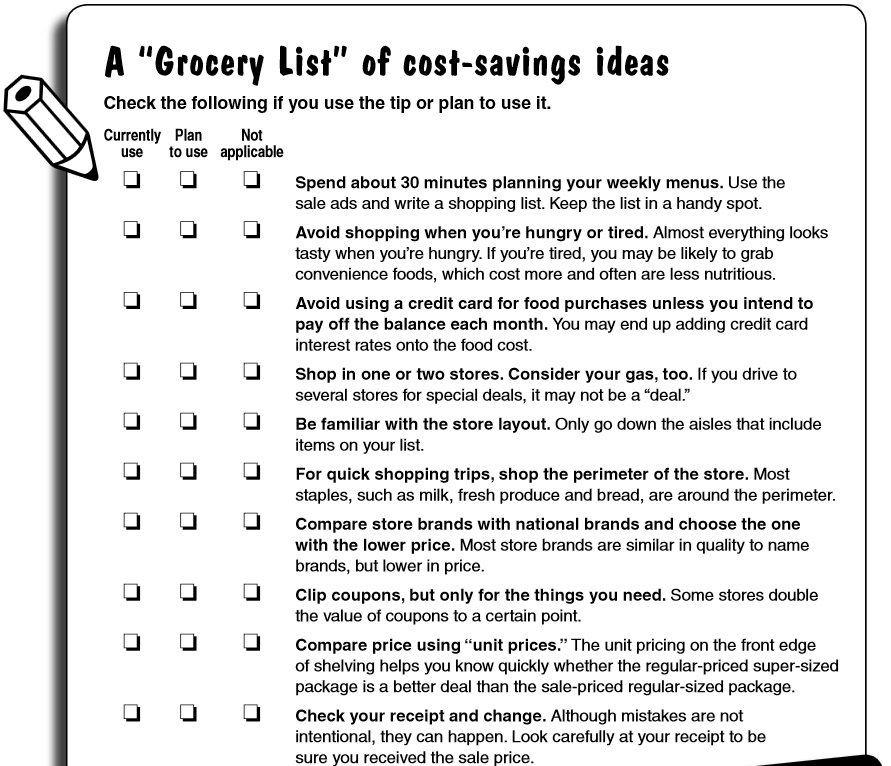
This material was funded by the U.S. Department of Agriculture’s Supplemental Food Assistance Program (SNAP). SNAP provides nutrition assistance to people with a low income. It can help you buy nutritious foods for a better diet. To find out more, contact your county social services office.
For more information about food safety and nutrition, contact your county office of NDSU Extension.
Visit the NDSU Extension website.
For more information about healthful eating for the entire family.


